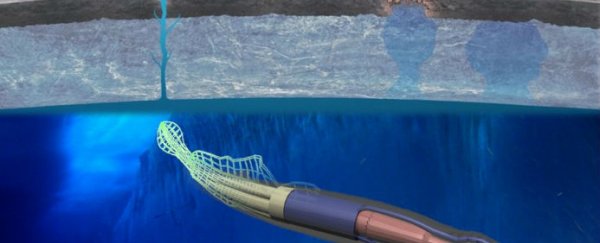A soft-bodied robotic squid, which propels and powers itself with electrical energy scavenged from its local environment, could one day be used to explore oceans on distant planets and their moons, researchers say.
A team from NASA and Cornell University in the US is working on advancing the concept for their squid-inspired rover, and say it could be used to explore Jupiter's fourth largest moon, Europa.
Scientists strongly suspect that Europa has a vast liquid ocean beneath its icy surface, and for this reason, have prioritised it in their search for moons and planets in our Solar System that might harbour alien life.
Earlier this year, NASA administrator Charles Bolden earmarked $100 million in the agency's budget to plan for a future mission to Europa.
This rover could be a prime candidate for exploration when the mission finally eventuates.
It would feature tentacle-like structures that serve two functions: they would act as electrodynamic tethers, able to harvest power from fluctuating magnetic fields in the local environment, and as a means of bio-inspired propulsion.
The electrical energy that the robot scavenges would be used to power all of its subsystems, including one that breaks water down into hydrogen and oxygen. These two gases would be stored internally in the body and limbs of the robot.
As Evan Ackerman explains for IEEE Spectrum:
"The gases can then be mixed and ignited on demand, which could propel the bot in one of two ways: the explosions could either cause the limbs and body of the bot to expand and contract, allowing it to 'swim,' or you could use the explosions much more directly, directing the exhaust out the back of the robot, causing it to jet forward like an octopus."
The researchers also suggest that this could aid propulsion across hard surfaces.
It's certainly an ambitious concept, and it's a long way from ready. NASA has awarded the project a grant under its Innovative Advanced Concepts (NIAC) program, which will help it progress from Technology Readiness Level 1 to level 2.
A mission-ready technology needs to be at level 9.
Still, the concept offers some intriguing possibilities for similar technologies. Namely, bypassing the need to power rovers with limited-lifetime batteries, large solar arrays, or nuclear power.
"In this one respect, it is a breakthrough concept," the researchers from Cornell University write in their project description.
Solar radiation would be difficult to efficiently harness at distances as far away from the Sun as Jupiter, and even more so if the robot was operating under a thick layer of ice. And NASA has stalled or cancelled much of its research on small nuclear power sources for interplanetary missions and rovers, Ackerman points out. The squid-inspired robot offers a novel power generation option for a very extreme environment.
Once on the ground - or underwater - on Europa, the space squid's soft-bodied design will allow it to overcome some of the difficulties usually experienced by mechanisms operating in fluids, such as managing the stress of high pressure on internal components.
Covered in a stretchy, electroluminescent skin, it will be able to light up the local marine environment for better visibility and underwater imaging.
If realised, this awesome robot could be summed up in just one word: badass.
Editor's recommendations:
